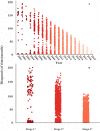Epidemiological Characteristics and Transmissibility of Human Immunodeficiency Virus in Nanning City, China, 2001-2020
- PMID: 35004557
- PMCID: PMC8733253
- DOI: 10.3389/fpubh.2021.689575
Epidemiological Characteristics and Transmissibility of Human Immunodeficiency Virus in Nanning City, China, 2001-2020
Abstract
Background: Human immunodeficiency virus (HIV) is a single-stranded RNA virus that can weaken the body's cellular and humoral immunity and is a serious disease without specific drug management and vaccine. This study aimed to evaluate the epidemiologic characteristics and transmissibility of HIV. Methods: Data on HIV follow-up were collected in Nanning City, Guangxi Zhuang Autonomous, China. An HIV transmission dynamics model was built to simulate the transmission of HIV and estimate its transmissibility by comparing the effective reproduction number (Reff ) at different stages: the rapid growth period from January 2001 to March 2005, slow growth period from April 2005 to April 2011, and the plateau from May 2011 to December 2019 of HIV in Nanning City. Results: High-risk areas of HIV prevalence in Nanning City were mainly concentrated in suburbs. Furthermore, high-risk groups were those of older age, with lower income, and lower education levels. The Reff in each stage (rapid growth, slow growth, and plateau) were 2.74, 1.62, and 1.15, respectively, which suggests the transmissibility of HIV in Nanning City has declined and prevention and control measures have achieved significant results. Conclusion: Over the past 20 years, the HIV incidence in Nanning has remained at a relatively high level, but its development trend has been curbed. Transmissibility was reduced from 2.74 to 1.15. Therefore, the prevention and treatment measures in Nanning City have achieved significant improvement.
Keywords: acquired immune deficiency syndrome; dynamics; human immunodeficiency virus; transmissibility; transmission model.
Copyright © 2021 Lin, Deng, Rui, Guo, Hu, Chen, Tang, Zhou, Zhao, Lin, Zhu, Yang, Wang, Xu, Liu, Yang, Li, Li, Luo, Liu, Liu, Huang, Yao, Nong, Nong, Wu, Luo, Chen, Frutos, Yang, Li, Cui and Chen.
Conflict of interest statement
The authors declare that the research was conducted in the absence of any commercial or financial relationships that could be construed as a potential conflict of interest.
Figures










Similar articles
-
Effectiveness of human immunodeficiency virus prevention strategies by mapping the geographic dispersion pattern of human immunodeficiency virus prevalence in Nanning, China.BMC Public Health. 2024 Mar 16;24(1):831. doi: 10.1186/s12889-024-18345-9. BMC Public Health. 2024. PMID: 38493080 Free PMC article.
-
[Study on the prevalence of loss to follow-up and risk factors among human immunodeficiency virus (HIV)/acquired immunodeficiency syndrome (AIDS) patients in Baoshan city, Yunnan province].Zhonghua Yu Fang Yi Xue Za Zhi. 2014 Aug;48(8):688-92. Zhonghua Yu Fang Yi Xue Za Zhi. 2014. PMID: 25388464 Chinese.
-
Characteristics of Migration Among HIV-Positive MSM - Guangxi Zhuang Autonomous Region, China, 2005-2021.China CDC Wkly. 2023 Mar 31;5(13):287-291. doi: 10.46234/ccdcw2023.052. China CDC Wkly. 2023. PMID: 37139145 Free PMC article.
-
Epidemiology of acquired immunodeficiency syndrome and human immunodeficiency virus infection in adolescents.Pediatr Infect Dis J. 1991 Apr;10(4):322-8. doi: 10.1097/00006454-199104000-00012. Pediatr Infect Dis J. 1991. PMID: 2062630 Review.
-
HIV Epidemiology and Prevention in Southwestern China: Trends from 1996-2017.Curr HIV Res. 2019;17(2):85-93. doi: 10.2174/1570162X17666190703163838. Curr HIV Res. 2019. PMID: 31269884 Free PMC article. Review.
Cited by
-
Effectiveness of human immunodeficiency virus prevention strategies by mapping the geographic dispersion pattern of human immunodeficiency virus prevalence in Nanning, China.BMC Public Health. 2024 Mar 16;24(1):831. doi: 10.1186/s12889-024-18345-9. BMC Public Health. 2024. PMID: 38493080 Free PMC article.
-
Tuberculosis among Ambulatory People Living with HIV in Guangxi Province, China: A Longitudinal Study.Int J Environ Res Public Health. 2022 Sep 27;19(19):12280. doi: 10.3390/ijerph191912280. Int J Environ Res Public Health. 2022. PMID: 36231580 Free PMC article.
-
Immunogenicity and safety of an inactivated SARS-CoV-2 vaccine in people living with HIV: A cross-sectional study.J Med Virol. 2022 Sep;94(9):4224-4233. doi: 10.1002/jmv.27872. Epub 2022 May 28. J Med Virol. 2022. PMID: 35585023 Free PMC article.
References
Publication types
MeSH terms
LinkOut - more resources
Full Text Sources
Medical
Miscellaneous

